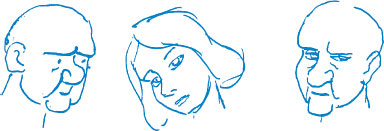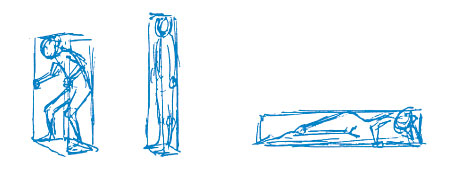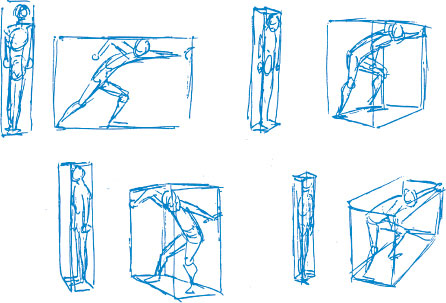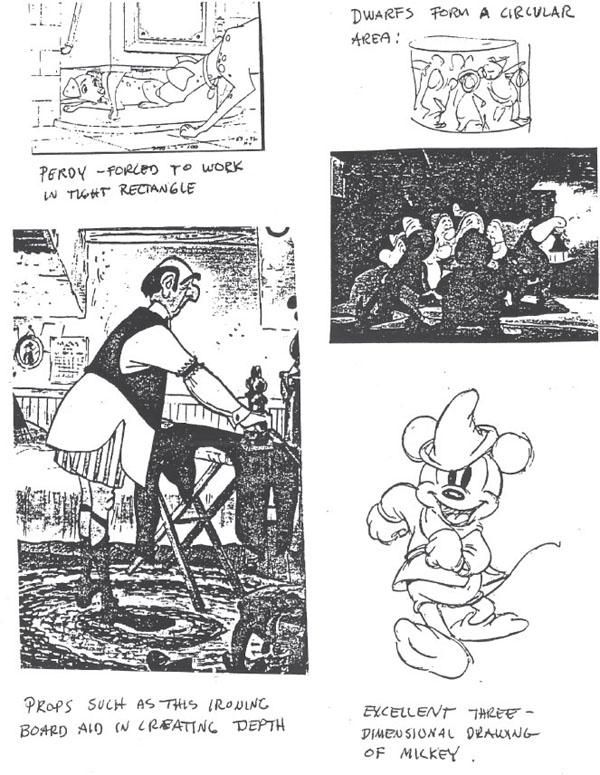65 Using the Rules of Perspective
As artists we see through eyes that constantly search for shape, gesture, color, contrast, etc. When we draw from the model (or from life in general) we have a tendency to feature shape. A thing is either round, oblong, or rectangular or some combination of each. These in turn create the two-dimensional negative space that forms a relationship between one or more objects or parts of one object. It requires an extra nudge of observation to see things as third dimensional an two extra nudges to translate that third dimension onto a two-dimensional surface. The rules of perspective such as
![]()
(diminishing size)
![]()
(overlap) and
![]()
(surface texture) are invaluable for this purpose.
Also, since we do see things as basic shapes, we must think of the shapes as being third dimensional. For instance, a rectangle
![]()
is as flat as the paper it is drawn on. But add the rule of diminishing size and we get a somewhat third dimensional shape.
![]()
Add some bulk to that shape and the third dimensional feeling (or illusion) is augmented.
![]()
Add a slight angle or give it a twist and the illusion is even more apparent.

It is more difficult to achieve three dimensions with an orb or spherical shape, but it can be done with the aid of the rules of perspective. For instance when drawing a head, the nose, forehead, cheeks, ears, and chin may be thought of as shapes that overlap other shapes.

If the model strikes a pose that forms a rectangle viewed straight on

that rectangle from a three-quarter angle would look like this.
![]()
The degree of diminishing size (perspective wise) would depend on how close to the model (or object) we are and at what angle we are seeing it.
If our eye is one foot from a rectangle measuring 17 X 20”

at a 7/8° angle
![]()
the far side will appear to be about 7 inches high. Meaning that within 20 inches the upright line has diminished by more than one half. At 6 feet it is only 4inches shorter, and at 12 feet it is only 2 inches shorter. So the ratio of diminishing perspective lessens as the distance increases.
So the factors that concern us are how far from the object we’re and what the angle of perspective is; that is
![]()
One-quarter, or
![]()
three-quarters. We have gotten a little technical here but it is only to stress the importance of thinking and seeing things in third dimensional space. If we carried the premise of the diminishing rectangles further we could divide all space into cubes. Lay-out and background artists are more apt to think in these terms because they deal with scenery that involves space and objects in that space.

For the artist drawing or animating a figure, whether human or cartoon, we are dealing with only one cube of that space at a time, a variable cube that encompasses the perimeters of the figure and its gestures.

The imaginary cube reveals the third dimensional negative space so important in capturing a third dimensional drawing on a two-dimensional surface. If all the rules of perspective aren’t considered while making a drawing or animating a scene, the character would end up looking as though it were confined between two panes of glass, forcing it to do its thing on a two-dimensional stage. Extending that plane into the third dimension gives the character depth as well as lateral space to move in.
Third dimensional negative space can also be helpful in creating tension in a pose or action.


